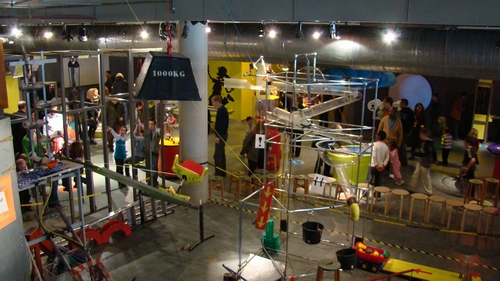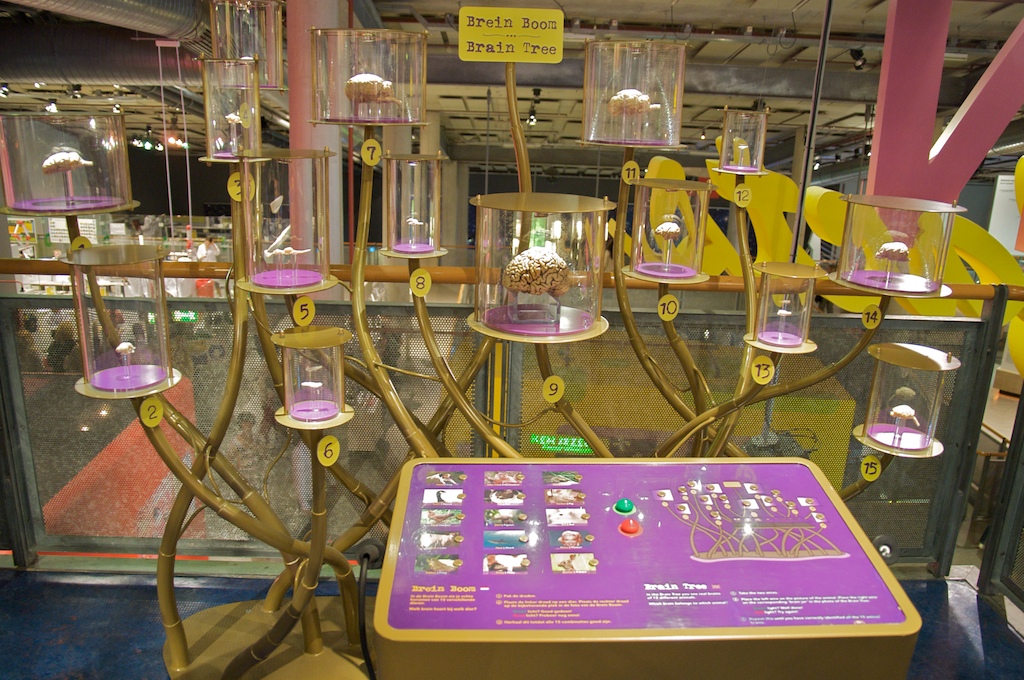NEMO (museum) on:
[Wikipedia]
[Google]
[Amazon]
NEMO Science Museum (from
Nieuwe visuele stijl
(in Dutch), NEMO Science Museum. Retrieved 20 April 2016.

 Inside the lobby there is a small cafeteria and a gift shop which sells small scale copies of some of the attractions at Nemo like the giant domino set and the DNA experiments.
The main concepts on the first floor are DNA and chain reactions which include a room with giant dominoes with contraptions like a giant bell and a flying car. Also on the first floor is a show on the half-hour, which features a large chain reaction circuit.
On the second floor is a ball factory where small plastic balls are sent on a circuit where participants are to group them in weight, size, and color and then send them to a packing facility where the balls go into a small metal box. There are five stations at which the people stick magnetic barcodes on the boxes and send them off to start the circuit again. On the second level, there is also a small cafeteria and a movie and performance hall where various acts and movies about science are shown. The second floor also features a display on the
Inside the lobby there is a small cafeteria and a gift shop which sells small scale copies of some of the attractions at Nemo like the giant domino set and the DNA experiments.
The main concepts on the first floor are DNA and chain reactions which include a room with giant dominoes with contraptions like a giant bell and a flying car. Also on the first floor is a show on the half-hour, which features a large chain reaction circuit.
On the second floor is a ball factory where small plastic balls are sent on a circuit where participants are to group them in weight, size, and color and then send them to a packing facility where the balls go into a small metal box. There are five stations at which the people stick magnetic barcodes on the boxes and send them off to start the circuit again. On the second level, there is also a small cafeteria and a movie and performance hall where various acts and movies about science are shown. The second floor also features a display on the
latin
Latin (, or , ) is a classical language belonging to the Italic languages, Italic branch of the Indo-European languages. Latin was originally a dialect spoken in the lower Tiber area (then known as Latium) around present-day Rome, but through ...
''Nobody'') is a science centre
A science museum is a museum devoted primarily to science. Older science museums tended to concentrate on static displays of objects related to natural history, paleontology, geology, industry and industrial machinery, etc. Modern trends in m ...
in Amsterdam
Amsterdam ( , , , lit. ''The Dam on the River Amstel'') is the capital and most populous city of the Netherlands, with The Hague being the seat of government. It has a population of 907,976 within the city proper, 1,558,755 in the urban ar ...
, Netherlands
)
, anthem = ( en, "William of Nassau")
, image_map =
, map_caption =
, subdivision_type = Sovereign state
, subdivision_name = Kingdom of the Netherlands
, established_title = Before independence
, established_date = Spanish Netherl ...
. It is located in the Oosterdokseiland neighbourhood in the Amsterdam-Centrum
Amsterdam-Centrum is the inner-most borough and historical city centre of Amsterdam, Netherlands, containing the majority of the city's landmarks. Established in 2002, Amsterdam-Centrum was the last area in the city to be granted the status of ...
borough, situated between the Oosterdokseiland and the Kattenburg. The museum has its origins in 1923, and is housed in a building designed by Renzo Piano
Renzo Piano (; born 14 September 1937) is an Italian architect. His notable buildings include the Centre Georges Pompidou in Paris (with Richard Rogers, 1977), The Shard in London (2012), the Whitney Museum of American Art in New York City (2 ...
since 1997. It contains five floors of hands-on science exhibitions and is the largest science center in the Netherlands. It attracts around 670,000 visitors annually, which makes it the eighth most visited museum in the Netherlands.
History
The museum has its origins in 1923, when the ''Museum van den Arbeid'' ( en, Museum of Labor) was opened by the artistHerman Heijenbrock
Herman Heijenbrock (1871 in Amsterdam – 1948 in Blaricum), was a Dutch writer, painter, pastel draughtsman, and lithographer. He founded the "Museum van den Arbeid" in 1923, which later became NEMO (museum), NEMO Science Museum.
Biography
H ...
on the Rozengracht
The Rozengracht is a street in the Jordaan neighbourhood of Amsterdam.
It runs between the Prinsengracht at the Westermarkt and the Singel canal at De Clercqstraat.
The name means "Rose canal".
The Rozengracht is one of the six former canals in ...
in Amsterdam. In 1954 the name was changed to the NINT or ''Nederlands Instituut voor Nijverheid en Techniek'' ( en, Dutch Institute for Labor and Technology), and in 1997 it changed again to ''newMetropolis''. The name ''Science Center Nemo'' was introduced in 2000. In 2016, the name was changed to ''NEMO Science Museum''.(in Dutch), NEMO Science Museum. Retrieved 20 April 2016.
Exhibitions

 Inside the lobby there is a small cafeteria and a gift shop which sells small scale copies of some of the attractions at Nemo like the giant domino set and the DNA experiments.
The main concepts on the first floor are DNA and chain reactions which include a room with giant dominoes with contraptions like a giant bell and a flying car. Also on the first floor is a show on the half-hour, which features a large chain reaction circuit.
On the second floor is a ball factory where small plastic balls are sent on a circuit where participants are to group them in weight, size, and color and then send them to a packing facility where the balls go into a small metal box. There are five stations at which the people stick magnetic barcodes on the boxes and send them off to start the circuit again. On the second level, there is also a small cafeteria and a movie and performance hall where various acts and movies about science are shown. The second floor also features a display on the
Inside the lobby there is a small cafeteria and a gift shop which sells small scale copies of some of the attractions at Nemo like the giant domino set and the DNA experiments.
The main concepts on the first floor are DNA and chain reactions which include a room with giant dominoes with contraptions like a giant bell and a flying car. Also on the first floor is a show on the half-hour, which features a large chain reaction circuit.
On the second floor is a ball factory where small plastic balls are sent on a circuit where participants are to group them in weight, size, and color and then send them to a packing facility where the balls go into a small metal box. There are five stations at which the people stick magnetic barcodes on the boxes and send them off to start the circuit again. On the second level, there is also a small cafeteria and a movie and performance hall where various acts and movies about science are shown. The second floor also features a display on the water cycle
The water cycle, also known as the hydrologic cycle or the hydrological cycle, is a biogeochemical cycle that describes the continuous movement of water on, above and below the surface of the Earth. The mass of water on Earth remains fairly co ...
a display on electricity and a display on metals and buildings.
The third floor has a giant science lab in which people can do science experiments such as testing vitamin C in certain substances and looking at DNA. There is also a small section on money and business.
On the fourth floor is a section about the human mind, it has such experiments as memory tests, mind problems, and sense testers. The fourth floor is quite dark which adds to the eeriness of the surroundings.
The fifth floor or upper deck has a cafeteria, a children's play area and a great view of the city surroundings.
References
External links
* * {{Authority control 1923 establishments in the Netherlands Museums established in 1923 Museums in Amsterdam Renzo Piano buildings Science and technology in the Netherlands Science museums in the Netherlands